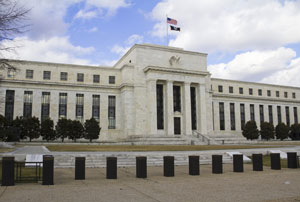Comments on the FOMC's Amendments to Its Statement on Longer-Run Goals

In this post, I focus on the inflation-targeting portion of the Federal Open Market Committee’s (FOMC) broader mandate of promoting maximum employment, stable prices and moderate long-term interest rates, and why I dissented on the proposed amendments to the “Statement of Longer-Run Goals” at the FOMC’s January 2016 meeting.
The FOMC has an inflation target of 2 percent, which it made explicit four years ago in its January 2012 “Statement on Longer-Run Goals and Monetary Policy Strategy.” At last month’s meeting (Jan. 26-27), the FOMC revised this statement to underscore that the inflation target is symmetric. In particular, the committee added the word “symmetric” in the phrase “… this symmetric inflation goal …” in paragraph three of the statement. But the FOMC also added the following sentence to the statement in paragraph three: “The Committee would be concerned if inflation were running persistently above or below this objective.”1 I dissented on adding this sentence as written because I view it as insufficiently forward-looking and therefore potentially confusing for Fed communications.2 I will outline three examples of the nature of this confusion below.
General Agreement
Before getting to the examples, let me stress that I agree with the rest of the statement and only opposed this proposed amendment. In particular, I have supported the statement in the past, and I have long advocated for defending the inflation target from both the high side and the low side, and so I support the newly introduced symmetry aspect. Nevertheless, the committee’s statement of longer-run goals is only reviewed once per year and so has a weighty status. For this reason, I felt it was particularly important to get the language to reflect as accurately as possible the nature of inflation targeting in the U.S. and that the “… were running …” sentence fell short of meeting this objective.
A central tenet of inflation targeting is that the future expectations about deviations of inflation from target are critically important, whereas the past misses of inflation from target caused by shocks that hit the economy are less important.3 In my view, this central tenet of inflation targeting should be reflected in the FOMC’s statement on longer-run goals.
Let’s now turn to three examples of what I view as inconsistencies between the new, backward-looking language in the statement of longer-run goals and committee practice.
Optimal Monetary Policy
The first example concerns calculations of fully optimal monetary policy. Some leading analyses show inflation remaining below 2 percent for the next several years, even under optimal or appropriate monetary policy.4 Thus, if such an approach to policy was adopted, the FOMC would not be particularly concerned about past inflation being below target, as the “… were running …” sentence suggests. The committee would instead focus on a monetary policy strategy that would return inflation to target over the next several years—a forward-looking approach.
To illustrate this forward-looking nature, when FOMC participants submit their economic projections each quarter, they do so based on their own assumption of appropriate monetary policy. According to the latest projections from December, the median projection suggests that inflation will not return to 2 percent until 2018 under appropriate policy.5
FOMC Communications
A second example concerns current Fed policy statements. Recent communications on monetary policy decisions emphasize a criterion that the committee needs to be reasonably confident that inflation will return to target in the future. Indeed, when the FOMC decided to raise the policy rate from near zero at its December meeting, the post-meeting statement said that the committee “… is reasonably confident that inflation will rise, over the medium term, to its 2 percent objective.”6 This assessment is forward-looking. In contrast, the committee’s new language of “… if inflation were running …” in the statement on longer-run goals is a reference to past inflation, which renders it more backward-looking.
Past FOMC Behavior
The third example is historical. U.S. inflation frequently ran higher than 2 percent in the mid-2000s. During that period, the FOMC generally stressed that the relatively high inflation was likely due to temporary factors and that the committee expected inflation to return to lower levels under the policy that was in place.7 The FOMC did not show particular concern about past inflation misses, even though inflation persistently ran above 2 percent for several years. This was a forward-looking strategy, which again stands in contrast with the new sentence in the statement on longer-run goals.
As these three examples illustrate, the future path of inflation—rather than past inflation misses—is really the primary concern for inflation targeting. Unfortunately, in my view, the amended statement on longer-run goals does not completely characterize this reality. While I supported amending the statement to emphasize that the inflation goal is symmetric, I preferred to include language that stressed the forward-looking nature of inflation targeting.
Notes and References
1 See the latest “Statement on Longer-Run Goals and Monetary Policy Strategy” and the related press release on Jan. 27.
2 An example of language that I would have supported is “… were expected to run above or below ….”
3 Past misses would play a more important role in price-level targeting, but the committee has not adopted this approach to monetary policy.
4 For an example of this type of analysis, see the 2014 article by Flint Brayton, Thomas Laubach and David Reifschneider. In their calculations based on the latest data and model available at that time, inflation does not reach the target for several years under the optimal policy. (See Figure 5 in the article.) Brayton, Flint; Laubach, Thomas; and Reifschneider, David. “Optimal-Control Monetary Policy in the FRB/US Model,” FEDS Notes, Nov. 21, 2014.
5 FOMC’s Summary of Economic Projections, December 2015.
6 FOMC statement on Dec. 16, 2015.
7 For instance, during his testimony before Congress in February 2007, then-Chairman Ben Bernanke referenced “a waning of the temporary factors that boosted inflation in recent years.” During a speech in February 2006, he noted that the FOMC had been able to raise the policy rate in a more gradual and predictable fashion during the mid-2000s than during the 1970s, given that inflation expectations had remained low. See Bernanke, Ben S. “The Benefits of Price Stability,” speech on Feb. 24, 2006.
Additional Resources
- President Bullard’s website
- Regional Economist: What Does Data Dependence Mean?
- Speech: Inflation Targeting in the USA
This blog offers commentary, analysis and data from our economists and experts. Views expressed are not necessarily those of the St. Louis Fed or Federal Reserve System.
Email Us
All other blog-related questions



